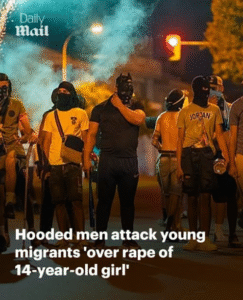When Fear Wears a Hood: A Tale of Violence, Blame, and the Fragility of Belonging
It began with a crime. A 14-year-old Spanish girl was allegedly raped in a park near Madrid by a Moroccan teenager living in a migrant reception center. The accusation alone was enough to ignite a firestorm. Days later, two hooded men attacked three people near that same center—two minors and an adult. One child was hospitalized. The attackers didn’t ask questions. They didn’t wait for a verdict. They came with fists and fury, cloaked in anonymity, armed with certainty.
This wasn’t just retaliation. It was a rupture.
And it didn’t happen in isolation. Just days earlier, Switzerland had erupted in riots after the death of Marvin “Shalom” Manzila, a 17-year-old migrant chased by police over a stolen scooter. He died in Lausanne. The streets burned. The grief was raw. The rage was louder.
Two countries. Two young lives. Two flashpoints. And beneath them, a shared tremor: the question of who belongs—and who doesn’t.
🧠 The Psychology of Scapegoating
When a crime is committed, we want answers. We want justice. But sometimes, we want something else more: simplicity. A villain. A group to blame. A narrative that makes the chaos feel ordered.
In Madrid, the alleged rape became more than a criminal case—it became a symbol. The suspect wasn’t just a teenager. He was a migrant. A Moroccan. A representative of “the other.” And in that framing, the crime metastasized. It wasn’t just one act—it became a referendum on immigration, integration, and identity.
The hooded attackers didn’t know the victims they assaulted. They didn’t care. They saw symbols, not people. And that’s the danger of scapegoating: it turns individuals into abstractions. It replaces nuance with rage.
🏛️ Politics in the Crossfire
Spain’s political landscape responded with predictable polarization. The conservative regional government, led by Isabel Ayuso, proposed repatriating the accused along with 37 other migrant minors deemed “maladapted”. The left-wing national coalition condemned the move, accusing Ayuso of exploiting the case to push a hardline anti-immigrant agenda.
Francisco Martín, the government’s delegate in Madrid, pointed out that the city had recorded 256 rapes this year—yet only this one sparked such political zeal. His words cut through the noise: “It is unacceptable to criminalize vulnerable populations.”
But the far-right Vox party seized the moment. Their spokesman, Javier Ortega Smith, blamed the assault on “progressive consensus” and “open borders,” calling for demonstrations outside the migrant center. The rhetoric was sharp, incendiary, and familiar.
This wasn’t just about one crime. It was about the weaponization of fear.
🔥 Switzerland’s Parallel Flame
In Lausanne, the death of Marvin Manzila lit a different fuse. He was a teenager. A migrant. A rapper. A suspect. Police chased him. He died. And the city erupted.
Containers burned. Streets filled with protesters. Flowers and candles marked the spot where Marvin fell. His death became a symbol—not just of police brutality, but of systemic neglect. Of lives lived on the margins. Of dreams cut short.
The riots weren’t just about Marvin. They were about every Marvin who never made the news. Every young migrant who felt invisible until they became a headline.
🧵 Threads of Identity
Both stories—Madrid and Lausanne—are stitched with the same thread: the fragility of belonging. Migrants are often caught in a paradox. Expected to assimilate, yet treated as perpetual outsiders. Blamed for systemic failures. Reduced to statistics. Or worse, to stereotypes.
The Moroccan teenager accused in Madrid is now in a closed juvenile prison. His guilt or innocence will be determined by the courts. But the public has already decided. And that decision has consequences—not just for him, but for every migrant child who walks past that reception center.
When violence is met with violence, the cycle deepens. And the victims multiply.
🕊️ The Cost of Silence
In moments like these, silence is complicity. But noise without clarity is chaos. The media plays a crucial role—amplifying facts, but also shaping perception. Headlines scream “rape,” “riot,” “migrant,” “attack.” But rarely do they pause to ask: Who are these children? What are their stories? What systems failed them?
The boy in Madrid. The boy in Lausanne. Both are more than their worst moment. More than their final breath. More than the labels assigned to them.
And yet, those labels stick. They shape policy. They fuel protests. They justify violence.
🧭 What Justice Demands
Justice is not vengeance. It is not collective punishment. It is not political theater. True justice requires patience, empathy, and accountability. It requires us to see individuals, not categories.
The hooded men in Madrid believed they were delivering justice. But they weren’t. They were delivering fear. They were reinforcing the very divisions that make crimes like these more likely.
And the politicians who exploit these moments for gain? They are not solving problems. They are deepening them.
💡 What We Must Learn
From Madrid and Lausanne, we must learn that violence is never isolated. It echoes. It spreads. It infects.
We must learn that young migrants are not threats—they are lives in progress. They are potential. They are vulnerable. And they deserve protection, not persecution.
We must learn that justice cannot be selective. That outrage must be consistent. That empathy must be louder than fear.
And we must learn that when the ground shakes—whether from riots or rhetoric—we must choose to build bridges, not barricades.


